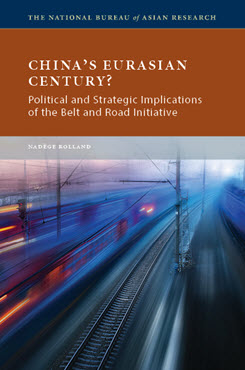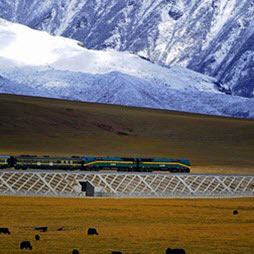NBR Books
China's Eurasian Century?
Political and Strategic Implications of the Belt and Road Initiative
In this monograph, Nadège Rolland (NBR) examines the drivers and goals of China’s Belt and Road Initiative and argues that the initiative reflects Beijing’s desire to shape Eurasia according to its own worldview and unique characteristics.
EXECUTIVE SUMMARY
China’s Belt and Road Initiative (BRI) has become the organizing foreign policy concept of the Xi Jinping era. The 21st-century version of the Silk Road will take shape around a vast network of transportation, energy, and telecommunication infrastructure, linking Europe and Africa to Asia and accompanied by strengthened monetary cooperation and increased people-to-people exchanges. Beijing sees physical infrastructure as a first step toward Eurasian integration, thanks in part to the creation of economic corridors that will enable greater regional policy coordination and foster a vibrant “community of common destiny.”
Drawing mostly from the work of Chinese official and analytic communities who are striving to make BRI a reality, this study examines the concept’s origins, drivers, and various component parts, as well as the accompanying ideational narrative and domestic and international objectives, as seen through Beijing’s eyes. While Beijing is selling the promise of economic development, its main focus is on the benefits that it hopes BRI will bring to China, not simply in the realm of economics but most importantly in the geopolitical domain. More robust engagement of the entire Eurasian continent through BRI is intended to enable China to better use its growing economic clout to achieve its ultimate political aims without provoking a countervailing response or a military conflict.
BRI thus serves the Chinese leadership’s vision of a risen China sitting at the heart of a Sinocentric regional order, the essence of Xi’s “dream of the great rejuvenation of the Chinese nation.” This vision reflects Beijing’s desire to shape Eurasia according to its own worldview and its own unique characteristics. More than a mere list of revamped infrastructure projects, BRI is a grand strategy that advances China’s goal of establishing itself as the preponderant power in Eurasia and a global power second to none.
POLICY IMPLICATIONS
- Despite China’s official narrative, BRI is not simply an economic development project, nor is it value-free. Its ultimate purpose is to build a Sinocentric Eurasian order in which Beijing’s influence and power have significantly expanded, authoritarian regimes have been consolidated, and liberal norms have receded. Western governments need to recognize that such an outcome would be contrary to both their interests and their values.
- BRI should not be mistaken for a generous aid program for the poorest countries in the region. Instead, the initiative will make it easier for Beijing to use its growing economic presence to coerce those who challenge its interests. Participation on China’s terms might have devastating consequences for the poorest economies in the region, which could find themselves saddled with unmanageable debt and forced to relinquish control over valuable national assets.
- In order to provide third countries with options and alternatives, Western powers need to stay engaged in Eurasia. But they should hold fast to, and if possible revitalize, ideas and programs that they began to implement across the region at the end of the Cold War. Existing multilateral instruments and institutions that abide by high standards, such as the Asian Development Bank, the World Bank, and the European Bank for Reconstruction and Development, should be used as main conduits for Western investment in the region.
- China needs the capital and cooperation of other advanced industrial nations to propel BRI’s projects and bolster its legitimacy. To that end, Beijing has launched a massive public relations campaign to portray the initiative as an opportunity not to be missed. Before agreeing to endorse or participate in BRI, Western countries should demand more transparency and higher standards from China. There should be no compromise about good governance, respect for human rights, environmental protection, and rule of law. Western countries should hold China to account on its pronouncements about shared interests and mutual benefits.
Table of Contents
Introduction
FREE INTRODUCTION
Chapter 1
Mapping the Silk Roads
Chapter 2
The Belt and Road Initiative: Bigger, Bolder, Better?
Chapter 3
Drivers of the Belt and Road Initiative
FREE CHAPTER
Chapter 4
A Vision for China as a Risen Power
Chapter 5
Hurdles on the Way
Chapter 6
Political and Strategic Implications of the Belt and Road Initiative




